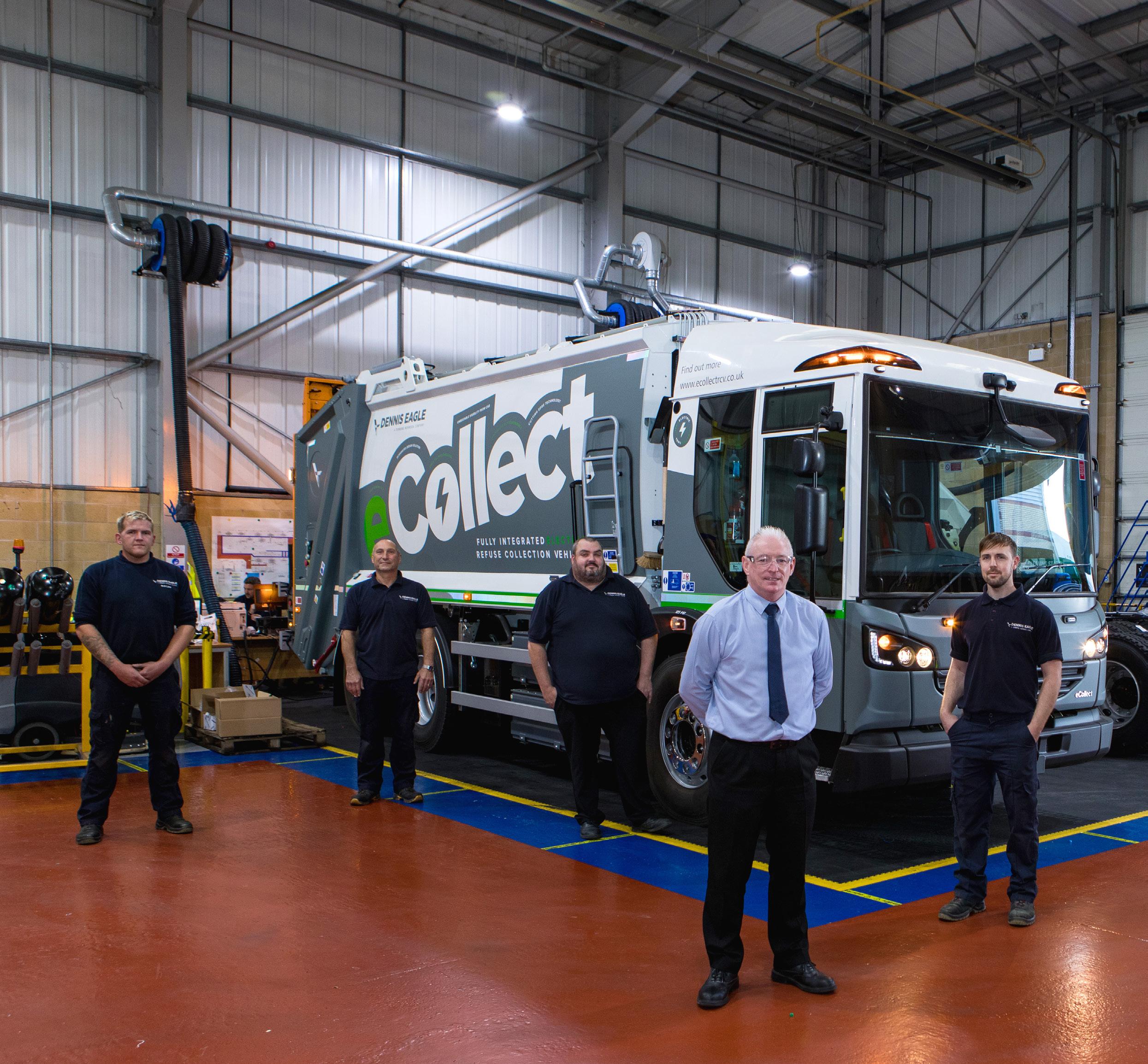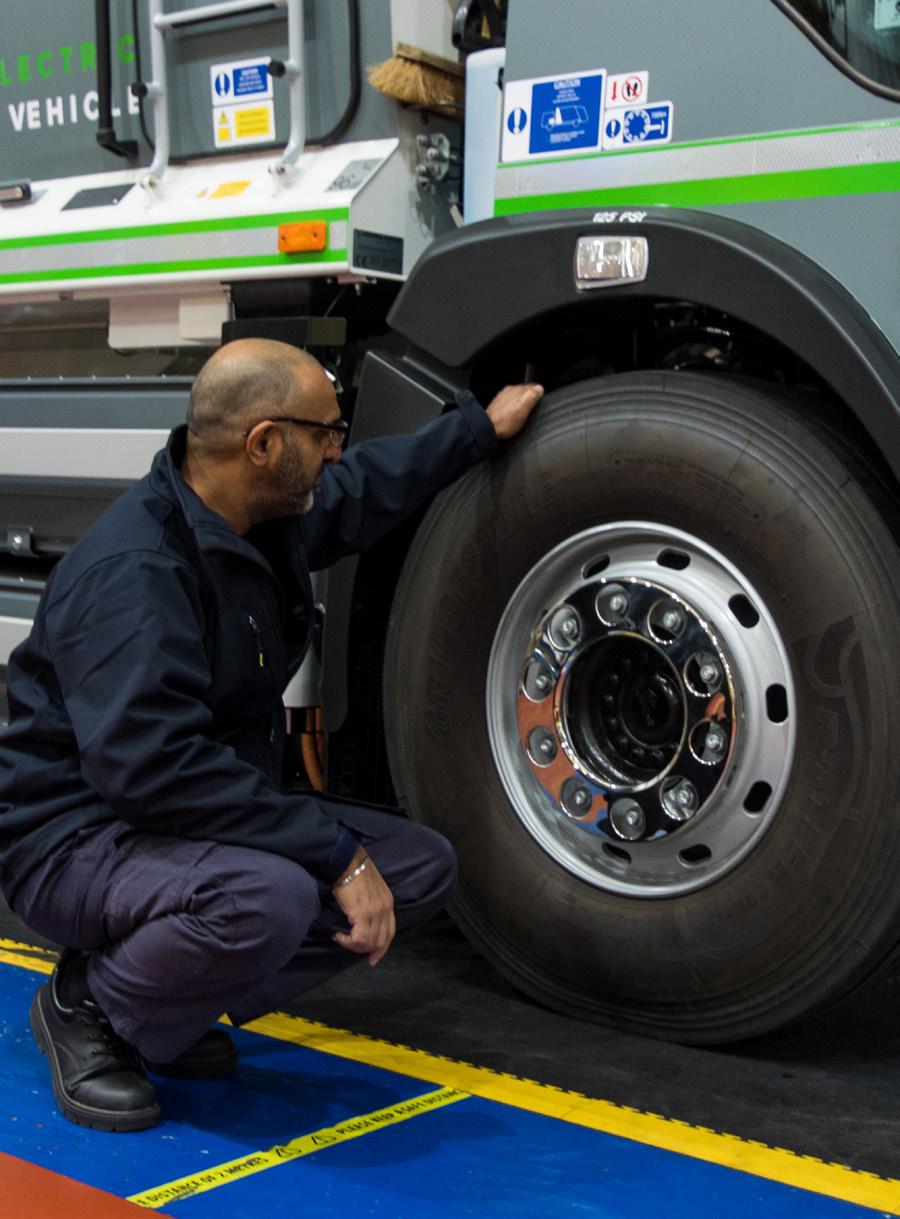
5 minute read
A genuine zero-emissions alternative
Alex Eddleston, Test Engineer

Left to right: Rob Lane, Rob Colley, Andy Gibbons, Alan Gordon and Richard Waldron

However, so often the devil’s in the detail and this was no exception. They found some parts they needed simply didn’t exist at the start of the project.
For smaller, highly specialised OEMs, such challenges can present mountainous obstacles But mountains are there to be climbed and our engineers achieved this.
The result is a landmark in electric vehicle history. After a relentless barrage of tests, the first eCollect built for a customer rolled out of the factory in the autumn of 2020.
The result
“I believe the eCollect marks a tipping point between diesel and future technology and so, to finally see it in production is special,” said Jon.
“On a personal note, the satisfaction comes from being instrumental in creating a team that could achieve this.
This is a relatively small group of flexible and high performing engineers. People as skilled and versatile as this probably don’t exist with many of the larger automotive manufacturers. It’s been very rewarding for them and for me. But we must not lose sight of precisely what we have achieved. The first eCollect is just one model, in one configuration, in one of our markets. What we have done is just open the door to electric RCVs. We understand that. And now the pressure is on to develop different vehicles.”
“All this reflects Dennis Eagle’s commitment to invest in technology, development and innovation,” concluded Jon. “I’m totally convinced it’s been worth it. Just look at the fruit of our labours.”
Bhav Chagger, Development Engineer
When he came here nine years ago, Jon had a team of 25. Now there are 67 engineers in design and development roles and (at the time of this interview) there are seven more positions being recruiting for.
But success doesn’t end there.
Major development projects often lead to spin-offs along the way. NASA famously developed Teflon while putting a man on the Moon. And as Dennis Eagle strived to produce a zeroemissions RCV, we had other successes too.
“The super lightweight RCV may have been too different to offer our customers at the time but what we learned didn’t go to waste,” confirmed Jon Sayers.
“The hydraulics system is already in use in the eCollect and the vehicle itself is now the focus of another project within the Group.
We also took a tonne out of the tailgate and are working out how best to use this.
“With electric vehicles, you get maximum torque when the vehicle is stationary and we wanted as much torque regeneration from the axles as possible.
But in normal axles this is restricted so we helped one of our contractors to develop an axle specifically for an electric vehicle. It worked and now they have set up a specialist e-axle business.
“And looking ahead, the low-entry cab we introduced so successfully to the UK many years ago has never been needed in Europe where crews still ride on the back of vehicles. But now, as part of the eCollect, it becomes much more of a proposition. I’m interested to see what happens.”
What do the first operators think?
The first eCollect off the production line was delivered to Nottingham City Council and a second soon followed. Others have been delivered to customers across the UK, including Greater Cambridge Shared Waste Services and Islington. So, what do they think of it so far?

Nottingham City Council
Nottingham already has more than 140 electric vehicles, from vans to sweepers but its eCollects have taken centre stage.
Andrew Smith, Assistant Manager (Fleet), said: “The electric RCV is the Holy Grail of municipal vehicles and we have wanted one for years. So, to finally get our hands on them and put them in to service is very satisfying indeed. Both eCollects are in operation and both are out-performing the diesels they replaced. In the first few weeks we saved around 60 to 70 litres of diesel per truck per day. That’s more than 360kg of CO2 per day we’ve not put into the atmosphere.”
Having used Dennis Eagle RCVs for years, Nottingham’s crews are very comfortable working with the eCollect. But what are they like to drive? They have been going out at 6.30am and finishing at around 1.30pm, collecting a full load then a smaller one – up to 18 tonnes in total,” said Andrew Smith.
“But they’re coming back with 40% charge remaining. And they’re
Image courtesy of Nottingham City Council
finishing quicker, shaving around an hour off the run time. The drivers love them – they don’t want to go back to diesel RCVs. They say eCollects are easier to drive and they particularly love the extra torque and manoeuvrability. Parts of Nottingham are quite hilly and diesel trucks can struggle with a big load but these vehicles take it in their stride.
“We’re delighted with them and we’re about to increase our charging infrastructure so we can expand our electric fleet – including more eRCVs – this year.”
Islington Council
Air pollution is high on the agenda for Islington which took delivery of two eCollects and plans to electrify its entire fleet to give local people cleaner air to breathe.
The council is also creating “PeopleFriendly Streets” include 29 designated “School Streets” across the borough.
Here, the eCollect comes into its own, its zero-emissions tag complemented by its much quieter operation and a cab rated by Transport for London as the safest on the roads.
The Executive Member for Environment and Transport is Councillor Rowena Champion who sees the eCollect as a practical solution.
“The arrival of our first eCollect was another step towards achieving our vision of a greener, healthier Islington where local people have cleaner air to breathe.
Rowena Champion, Councillor
“Air pollution remains a major health emergency across London and we know that we need to continue to improve air quality in our borough, especially for those who suffer from breathing difficulties.
“The eCollects will help to achieve this while also being cheaper to run.”




